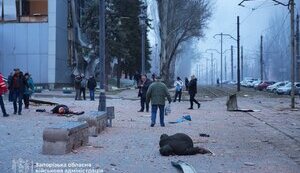UN: GABs’ strike on Zaporizhzhia resulted in largest number of civilian casualties in last two years

The Russian strike on Zaporizhzhia on January 8 resulted in the largest number of civilian casualties in a single incident in almost two years.
This is stated in the report of the UN Human Rights Monitoring Mission in Ukraine (UNHRMMU), Censor.NET reports with reference to Interfax-Ukraine.
Thus, according to the UNHRMMU, 13 people were killed and 110 others were injured as a result of the dropping of two bombs on an enterprise in Zaporizhzhia. "This number of deaths and injuries is the highest recorded by the UNHRMMU since the attack on a residential building in Dnipro on January 14, 2023, and the deadliest since the attack on a supermarket in Kostiantynivka, Donetsk region, on August 9, 2024," the report said.
The UN HRMMU visited the site of the attack on January 8, documented the damage and interviewed victims and witnesses. The UNHRMMU recorded the destruction of the industrial facility, as well as damage to buildings, vehicles and the road outside the enterprise. The attack took place in the afternoon when many workers were leaving the factory after their shifts. Many of the victims, including both employees and passersby, were killed or injured while on the street or in public transportation outside the facility.
"Glide bombs have become one of the biggest threats to civilians in cities along the frontline. They are also one of the main reasons why the number of deaths and injuries in 2024 increased by 30 percent compared to 2023," said UN HRMMU Chief Monitor Danielle Belle.
According to the UN HRMMU's verified data published in its monthly report on the protection of civilians, at least 2,064 civilians were killed and 9,089 injured in 2024, compared to 1,971 killed and 6,626 injured in 2023, largely due to the increased use of glide bombs by the Russian armed forces.
According to the HRMMU, aerial bombs accounted for 360 deaths and 1,861 injuries in 2024, which is three times the number of deaths and six times the number of injuries compared to 2023.
The increase in civilian casualties from aerial bombs in 2024 was the result of modifications that allow bombs to glide rather than just fall, which expanded their impact zone and now allow them to reach cities further from the front line, such as Kharkiv, Sumy and Zaporizhzhia.
The UN HRMMU first documented civilian casualties from such glider bombs in Kharkiv in early 2024, in Sumy and the region in August 2024, and in Zaporizhzhia in September 2024.
Since September 22, at least 35 civilians have been killed and 308 injured by glide bombs in Zaporizhzhia, accounting for 78% of the total number of casualties in the city. Other significant attacks using glide bombs in Zaporizhzhia include, inter alia, the attack on 6 December 2024, which killed ten civilians and injured 27, including three children, and the attack on November 7, 2024, which killed nine civilians and injured 42.
